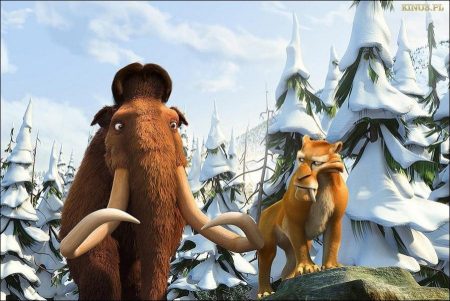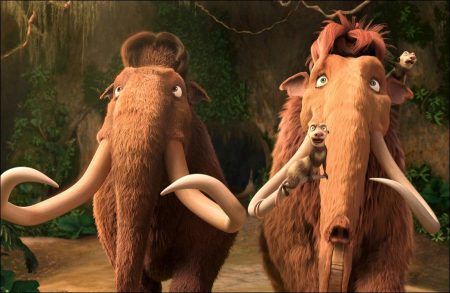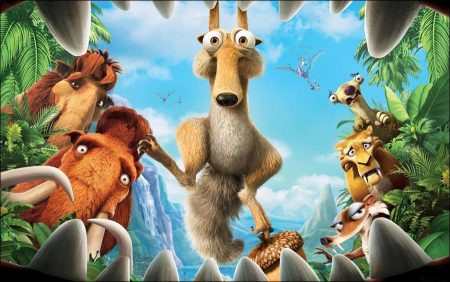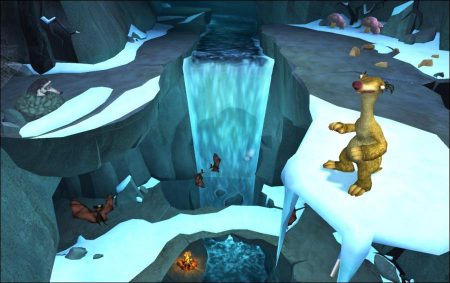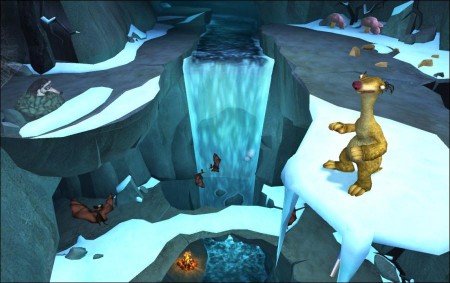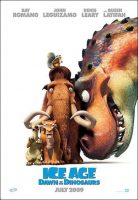Taglines: The sub-zero heroes are back, on an incredible adventure… for the ages.
Ice Age: Dawn of the Dinosaurs movie storyline. With mammoths experiencing no fewer than six trimesters of pregnancy, Ellie is more than ready for the baby’s arrival. She’s always been active and independent, so even though Manny wants her to take it easy, Ellie isn’t ready to slow down. Ellie’s pregnancy so consumes Manny that he is unaware that his friends are going through challenges and changes of their own.
Sid, who has developed a kind of younger brother/older brother relationship with Manny, feels that Manny won’t let him be a part of his burgeoning family. So when Sid discovers three enormous eggs in a cavern, he decides to start a family of his own. Manny pleads with Sid to return the eggs, but Sid insists on adopting them, and soon three adorable baby dinos are hatched. Although the baby dinos are twice Sid’s size, they immediately accept him as their mother and begin to mimic his every move, becoming “Mini-Sids.”
Sid’s parental instincts kick into overdrive, but the babies’ momma – a giant T-Rex – isn’t happy about the situation. Complications ensue – as they always do around Sid – leading everyone into an adventure in an incredible underground world.
Ice Age: Dawn of the Dinosaurs has everything audiences loved about the first two films, adding even more comedy, action, and spectacular visuals. Our beloved heroes live on, with some memorable new characters thrown into the “Ice Age” mix. Also new to the “Ice Age” franchise is an incredible and immense underground world populated by dinosaurs.
The lush world provides a sharp contrast to the wintry environs of the first two “Ice Age” films, and dwarfs even the vastness of the aboveground Ice Age. It’s a land of danger, massive creatures, mammal-eating plants, a daredevil weasel, a wily romantic foil for Scrat, named Scratte, and areas with names like the Chasm of Death, and the Plates of Woe. Even Manny the Mammoth – the B.M.O.C. (Big Mammal on Campus) in the Ice Age – feels puny in this immense world. “When the dinosaurs show up, Manny is no longer ‘king of the jungle,’” says comedy legend Ray Romano, who returns as the voice of filmdom’s most famous woolly mammoth.
The new world points to the filmmakers’ desire to put the Ice Age characters in different situations and give them unexpected challenges in each film. “We always want to see how far we can push the characters,” says Lori Forte, who has produced all three “Ice Age” films. Adds director Carlos Saldanha, who helmed “Ice Age: The Meltdown”: “ICE AGE: DAWN OF THE DINOSAURS is the most ambitious of the three pictures, by far. We plunk our heroes – who know only the Ice Age and a melting Ice Age – into a world that they’re not equipped to handle.” Co-director Michael Thurmeier says that the film has a new, more expansive look. “It almost feels like a genre movie, and that really drew me in. It’s still a smart, character-based comedy, but the underground world and characters provide an epic sweep and adventure that’s new to the ‘Ice Age’ franchise.”
The Ice Age gang’s game-changing, grand adventure starts out on familiar turf: the makeshift family comprised of mammoth Manny, his wife Ellie (who’s now expecting a mini-mammoth), Sid the sloth, Diego the saber-toothed tiger, and possums Crash and Eddie, is shifting as each finds his or her place within the family. “We wanted to maintain the emotional resonance of the previous films, in terms of Manny, Sid and Diego undergoing major changes and having their relationships continue to evolve,” says co-screenwriter Michael Berg. “We have become so familiar with the characters over the years, that we really care about them and want them to succeed, whatever changes they’re undergoing,” adds Berg’s writing partner, Peter Ackerman.
Manny, the de facto leader of the herd, prepares to face a new challenge – parenthood. He’s taking it very, very seriously, going so far as trying to baby-proof nature itself by removing the innumerable stones, twigs and other potential “hazards” around him. Frantic preparations for fatherhood are clearly something that Manny’s alter-ego, Ray Romano, identifies with. “It wasn’t that different from my own life,” he notes. “Getting crazy preparing for a new arrival comes with the territory.”
But marriage does agree with Manny, who’s very much in love with his bride Ellie, having overcome a rocky start to their relationship in “Ice Age: The Meltdown.” “It’s a good, typical marriage,” says Romano. “Manny and Ellie are ready to start a family, which is a very natural thing.”
Romano also appreciated Manny’s arc through the three “Ice Age” films. “He was kind of a misanthrope in the first film, with a real chip on his shoulder,” he says. “Little by little, Manny’s developed friendships, found love, and become a more well-rounded guy.”
With mammoths experiencing no fewer than six trimesters of pregnancy, Ellie is more than ready for the baby’s arrival. She’s always been active and independent, so even though Manny wants her to take it easy, Ellie isn’t ready to slow down. “Manny and Ellie are opposites in the way they’re handling imminent parenthood,” says Queen Latifah, who reprises the voice role she created in “Ice Age: The Meltdown.” “Manny is nervous and neurotic, trying to make sure that everything is perfect and safe for the baby. Ellie is more nurturing and begins to assume the mantle of matriarch of this family of friends.”
“Yeah, Manny is the brawn, but Ellie is the brains of that relationship,” quips Romano. The animators who helped bring Ellie to life weighed how best to depict Ellie’s pregnancy. “We didn’t want her to feel really heavy,” says lead animator Juan Carlos Navarro-Carrión. “She’s still the peppy and upbeat character we know from ‘Ice Age: The Meltdown,’ and we wanted to maintain that energy. We decided that her belly wouldn’t move a lot; it would just be there, and it wouldn’t slow her down. A pregnancy necessitates a careful negotiation of space and movement, to protect the belly and baby, and we were also mindful of that.”
Ellie’s pregnancy so consumes Manny that he is unaware that his friends are going through challenges and changes of their own. Sid, who has developed a kind of younger brother/older brother relationship with Manny, feels that Manny won’t let him be a part of his burgeoning family. So when Sid discovers three enormous eggs in a cavern, he decides to start a family of his own. Manny pleads with Sid to return the eggs, but Sid insists on adopting them, and soon three adorable baby dinos are hatched. Although the baby dinos are twice Sid’s size, they immediately accept him as their mother and begin to mimic his every move, becoming “Mini-Sids.” Sid’s parental instincts kick into overdrive, but the babies’ momma – a giant T-Rex – isn’t happy about the situation. Complications ensue – as they always do around Sid – leading everyone into an adventure in an incredible underground world.
While Sid’s relationship with Manny and his “Ice Age” family is changing, and his adventures take place mostly in new environs, what remains a constant is the character’s proclivity for wild antics, his desire to be taken seriously – and his heart. “With Sid, it’s all about heart …and being crazy – and we like it like that,” says Queen Latifah, with a smile.
In creating Sid’s voice for “Ice Age,” John Leguizamo gave him an unforgettable lateral lisp, after the actor learned that sloths store food inside their cheeks. In the new film, Leguizamo returns to that distinctive voice while finding inventive ways to add new dimensions to the character. “Sid wants to be taken seriously, get some respect, and be treated like an adult,” says Leguizamo. In this film, Sid embraces the formidable challenges of raising a trio of T-Rex hatchlings. “Well for one thing, the eggs are bigger than Sid, who has to carry them around,” adds Leguizamo. “And they don’t eat what Sid eats; Sid’s a vegetarian, and the ‘kids’ are meat-eaters. You know, it’s like you try and raise kids of any species. Good luck!”
Manny’s best pal, saber-toothed tiger Diego, is facing a different kind of crisis: Lately he’s been feeling more like a kitty cat than a fearsome feline, and fears that joining the herd is making him lose his edge. Instead of participating in the preparations for the baby’s arrival, Diego heads out on his own in search of adventure, wondering if it’s time for him to move on from the herd. “He’s breaking off on his own,” says actor-comedian Denis Leary, who completed voicing his third turn as Diego before returning to work on his hit series “Rescue Me.” “Diego also has some great moments with Ellie at a critical time for her, and that was a lot of fun to play.”
Leary continues to marvel at the franchise’s broad appeal, having witnessed it at screenings of the first two films. “I was with adults, teens, kids – everybody had a great time,” he remembers. What about the notion of a secret world lying under the ice? It’s great, says Leary, an avid amateur hockey player and fan: “But for me, personally, anytime there’s ice, I want to be on top of it, not below it.”
The next in our familiar quartet of heroes is the hapless yet indefatigable prehistoric squirrel/rat known as Scrat, whose raison d’être is an elusive acorn. In short, he’s nuts for a nut. The character’s exasperated squeaks, squeals, squawks, grunts and groans are again voiced by Chris Wedge, who was the director on “Ice Age” and an executive producer on the two follow-ups.
Initially envisioned for “Ice Age” as a peripheral character, Scrat’s explosive popularity in that first film’s teaser trailer led the filmmakers to expand the role significantly. “Ice Age: The Meltdown” explored new attitudes and frustrations for Scrat, as his quest remained unfulfilled. Not only did he instigate the meltdown and ensuing flood, Scrat ended up saving the day. He also displayed some impressive martial arts moves as he battled killer fish that got in his way.
ICE AGE: DAWN OF THE DINOSAURS ups the stakes even more for Scrat, giving him a rival for the nut – a wily and attractive female squirrel/rat named Scratte (rhymes with “sautee”). Their battle of the sexes brings a new level of fun, action and especially romance to the beleaguered figure. Indeed, burgeoning love and the fight for the nut go hand in hand for the rodent couple, no more so than during a scene that has them tangling – then tangoing – to Lou Rawls’ classic “You’ll Never Find Another Love Like Mine.” “When we sat down to map out the scene,” recalls director Carlos Saldanha, we said, ‘Okay, they’re fighting over the nut. What can we do beyond a standard fight scene that will make it romantic, but still action-packed?” The resulting sequence, like so many others, points to the filmmakers’ desire to break new ground with each “Ice Age” film. (Even the object of their pursuit – the nut – gets an expanded role in this film, warbling a heartfelt tune based on Gilbert O’Sullivan’s “Alone Again (Naturally),” with special lyrics by co-screenwriter Yoni Brenner.)
Scratte, like all the “Ice Age” characters, was designed by noted artist Peter de Sève, who has been with the films since the inception of “Ice Age.” He worked to make the two rodents physically similar, but with important distinctions. “Scratte is smarter than Scrat,” he points out. “And she’s more refined and evolved.”
Karen Disher, who heads the film’s story department, voices Scratte. But Disher’s responsibilities extended beyond her vocal work. Unlike the film’s main story, scripted by Michael Berg & Peter Ackerman and Mike Reiss and Yoni Brenner, from a story by Jason Carter Eaton, the story department, working closely with Saldanha, created the Scrat-Scratte scenes. Disher and her team embraced the task of inventing new challenges for the beloved Scrat. “Working on the Scrat-Scratte scenes is the purest form of animation,” she notes.
Another character new to the “Ice Age” universe is Buck, a swashbuckling, slightly crazed one-eyed weasel who accidentally fell into the world below. There, he had a fateful encounter with Rudy, a terrifying albino dinosaur who took out Buck’s eye – and Buck, the dino’s tooth – during their initial, fateful encounter. Like Captain Ahab in Moby Dick, Buck has devoted his life to vengeance on the mammoth creature that wronged him. “We always liked the idea of an adventurer – a guy who has mistakenly fallen into the wrong world, but found his destiny from his obsession with the white dinosaur Rudy,” says Saldanha. “This gives him a purpose, edge – and a sense of fun.” Adds co-screenwriter Michael Berg: “Buck has a self-mythologizing quality, and that makes him fun and bigger than life.”
The lone mammal in a world of giant lizards, Buck has been isolated for a long time – maybe too long; he’s prone to talking to the trees and shrubs surrounding him. Co-screenwriter Yoni Brenner notes that finding the origins of Buck’s bigger than life antics was a priority. “Carlos [Saldanha] wanted to make sure we defined a reason for Buck’s craziness. “We wanted to ground his behavior, at least a little bit. He had to be not only really funny, but make sense from a character point of view.”
Co-screenwriter Peter Ackerman adds that the longer he lived with the character, the more questions arose that needed answers. “You wonder, well, who is this guy? What is he doing in the underground world? How do the newly arrived Ice Age characters affect him? Does he want to join them?”
Buck has an anatomical advantage in dealing with the dangerous environment and his even more foreboding arch nemesis Rudy; character designer Peter de Sève, the animators, under supervising lead animator Galen Tan Chu, plus the film’s rigging department, made the character super-bendy in every direction. “Buck is a little crazy, as well as really athletic, so we really amped up his ability to twist, stretch and spiral,” says de Sève. Buck having only one good eye made him even more visually arresting, but presented some performance challenges for the animators.
In casting the role, the filmmakers wanted a voice that stood out from their previously established characters. “Every character in the ‘Ice Age’ films has a distinct voice, but they all somehow fit together,” says producer Lori Forte. Ultimately, it was British actor Simon Pegg who got the nod to voice Buck. “Simon has great comedic timing, and his work brought a completely different flavor to Buck,” Forte continues.
“We wanted a quality that conveyed a worldliness and range of experience that hadn’t yet been heard in an ‘Ice Age’ movie.” Pegg, who is currently on view as the starship engineer Scotty in director J.J. Abrams’ reboot of “Star Trek,” and who was acclaimed for his work in the edgy comedies “Shaun of the Dead” and “Hot Fuzz,” says he enjoyed the character, whom the actor gave a Cockney accent. “Buck really sparked my imagination. He’s full of energy and larger than life. I saw him as a cross between Indiana Jones and [“Apocalypse Now’s” powerful but demented] Col. Kurtz.”
Buck’s adventurous spirit and daredevil antics are embraced by sibling possums Crash and Eddie, both of whom we met in “Ice Age: The Meltdown.” Crash is still the loud-mouthed marsupial who loves extreme sports and trouble. Along with his brother Eddie, Crash eagerly joins Buck’s side to navigate the world below the ice and kick some dino butt. “Crash and Eddie are as out of their minds as ever; as they get older, they only get crazier” says Josh Peck who voices the role.
Peck, who stars in the popular television series “Drake & Josh,” also notes that he couldn’t ask for a better on-screen brother than Seann William Scott. Scott, whose many big-screen roles include the blockbuster comedy “American Pie” and the recent hit “Role Models,” enjoyed reprising the Crash- Eddie shenanigans with Peck, adding that this film resonated even more for him than with his animated debut with “Ice Age: The Meltdown.” “I did that one for my niece and nephew,” he notes. “I did ICE AGE: DAWN OF THE DINOSAURS for me.”
Crash, Eddie, Manny, Ellie and Diego track their buddy Sid – and the Momma Dinosaur that carried him off – into a mysterious world beneath the ice, one that they never knew existed and like nothing ever seen before. The underground world populated by dinosaurs is of a scale completely new to the Ice Age universe. It’s vast and treacherous, yet also beautiful, tranquil and wondrous. It harbors harrowing risks, along with delightful surprises.
Gareth Porter, who heads the film’s assembly department, explains the challenges in bringing this world to life: “We wanted to make it a challenging place to negotiate so that our characters would have an obstacle standing in the way of their goals. We worked very closely with the design department to establish the land’s vast scope through sweeping vistas; these provide a contrast with the more intimate sets, where we could develop our characters during their journey and not be overwhelmed with spectacle. In such a large space, that delicate balance between the epic and the intimate helps to keep the audience attuned to the needs of the story, feel close to the characters, and marvel at the exciting action.”
Art director Michael Knapp established a visual language based on color, lighting and shapes to help define the underground world. “The world’s colors and tones are lush,” he notes. “You can sense the humidity and see the sunlight filtering through the moisture. It’s essentially an enormous underground terrarium.”
Lighting this world was a formidable task. “I didn’t want it to feel like a cave, so we figured out ways of getting light down there, so it would feel like you were outdoors and have a sense of time passing,” Knapp adds. The subterranean world’s “sky” is literally an enormous sheet of rock and ice trough which light streams in from the world above. “Our ‘sky’ is actually a ceiling,” notes lighting supervisor Haji Uesato. “So we gave the ceiling a bluish hue.”
The denizens of this world presented unique challenges to the filmmakers. In a post-“Jurassic Park” movie landscape, it wasn’t easy, as Peter de Sève notes, to go to a new place with dinosaurs. “We all grew up with movie iterations of T-Rex, Triceratops and the Brachiosaur.” But de Sève, director Saldanha, and many of the creative and technical teams worked hard to introduce species of dinosaurs new to motion pictures, including Guanlong, nasty carnivores who hunt in groups, and who possess a spiked snout and quills sprouting from the back of its head.
de Sève worked closely with the film’s modeling department, headed by David Mei, to fine tune characters, both new and familiar to the legions of “Ice Age” fans. Regarding the dinosaur creations, Mei notes that “they’re real and scary, but they belong in our movie and not to the real world.”
Above this world lies a more familiar environment – the vast frozen tundra introduced in the original film. That look is largely recreated for the new picture, even though “Ice Age: The Meltdown” presented environments where the ice was melting. “For ICE AGE: DAWN OF THE DINOSAURS, we get a sense that the world has chilled over again,” explains Michael Knapp. “The ‘Meltdown’ has re-frozen. In seasonal terms, the first film moved from fall into winter. The second film was winter moving into spring, and this one re-establishes the Ice Age.”
David Mei and his modeling department devised two digital backlots – one for the frozen landscape above ground, the other for the lush enormous world below – all in Blue Sky Studios’ computers. Designing and building the sets, virtually, had distinct advantages in bringing to life the scale and scope of the two worlds. “The computer doesn’t know it’s a computer, so we can tell it that one unit equals a mile,” he points out. “When we build a set in the computer, it’s in miles, so the set of the underground world is literally the size of Westchester County. And we could shoot in any direction we wanted.”
After the modeling department completed its work on the sets and characters, the rigging group, led by Jeff Brodsky, put all the bones and moves on the characters, as well as setting up skeletal structures, musculatures, facial expressions, and controls for the characters’ jaws, brows and eyelids. The layout department, headed by Robert Cardone, provided continuity from shot to shot, making sure the show flow was working. The animation department, led by senior supervisor animator Galen Tan Chu, dealt with anything that moved, playing a key role in creating the characters’ performances. The hub through which all of this work flowed was Editorial, led by editor Harry Hitner.
A new element in the “Ice Age” filmmaking process is 3-D. Moviegoers at many theaters throughout the world will be able to experience their favorite characters, as well as some stunning new environments, in 3-D digital presentation. But the ICE AGE: DAWN OF THE DINOSAURS filmmakers were intent on using the process more to provide a fully immersive experience, than to startle them with “gotcha!” moments. “3-D made us more aware of composition – of camera and character placement,” says Saldanha. “What I didn’t want to do was create shots that yelled, ‘Hey, look at me!’ If we decided that 3-D would enhance a specific shot or story point, then we’d use it, without sacrificing the 2-D composition.”
Adds producer John C. Donkin: “We wanted the 3-D to provide an enhanced experience, not THE experience. We’re not doing the ‘jab the audience in the eye with sticks and stuff’’ thing. It’s not necessary; the movie and characters themselves will carry the moments.”
“We’ve been very critical with ourselves to make sure we can produce the best [3- D] we can,” says stereoscopic supervisor Jayme Wilkinson. Wilkinson points to some big action scenes enhanced by 3-D, including flying sequences, and one depicting Sid trying to catch the elusive dinosaur eggs. But other less frenetic sequences also point to 3-D’s immersive and fun qualities. “When Scrat is literally sniffing around for the acorn and for Scratte, his nose tales center stage,” says Wilkinson. “And when you meet Scratte, there are flower petals floating in the background, and you want to reach for the screen and grab them.”
Two-time Oscar-winning sound designer Randy Thom’s work further enhances the immersive experience. Thom, whose recent credits include the acclaimed animated features “Ratatouille,” “Coraline” and “Dr. Seuss’ Horton Hears a Who!,” came up with unique dinosaur sounds – from the cute, baby dinos, to momma T-Rex, to the terrifying albino Baryonyx dino Rudy. “Character voices are always the toughest,” says Thom, who also created the sounds of the melting world in the second “Ice Age” film. “We challenged ourselves to make the dinosaur sounds bigger, better and scarier than past movies with dinosaurs.”
Thom’s principal tool in capturing the unique voices of the title creatures was, as he says, “going out in the real world and finding animals that make sounds that you can twist, manipulate and control with other sounds.” For some super-sized dinosaurs, Thom started with recordings of elephants in Africa and at a shelter in Thailand. Later, he altered the recordings “pitching them down,” to make the dinosaur sounds even more robust. For the fearsome Rudy, Thom tweaked some elephant roars captured during the creatures’ mating season.
For the kindler, gentler dinosaurs, which in the film are observed eating plants, Thom worked with…camel sounds. “They make funny noises,” says Thom. “We happened on camels, and discovered that when they clear their throats, it almost sounds like coughing.” It was a perfect match for that species of dinosaur.
Thom also designed sounds the sources of which are unseen, like birds or amphibians calling off in the distance. Again, Thom made some unexpected choices to work from. For example, a squawking, scary-sounding pterodactyl came from a pig squealing. “In a way,” Thom jokes, “pigs actually do fly in this film!”
Thom’s sound design was fully integrated into composer John Powell’s rich musical score. Having scored the previous “Ice Age” films, Powell embraced the opportunity to expand the musical themes of the ever-evolving heroes and their relationships with one another. Ellie’s pregnancy was a particular challenge, and coming up with new a theme for Buck, was also a priority.
As the film’s intricate, lengthy and always challenging post-production process draws to a close, Carlos Saldanha reflects on his experiences with these characters. “I love the chance to follow these characters that everyone seems to love, continuing to explore them as they evolve. But it’s equally gratifying to create a new world, energy and story path for them.” Co-screenwriter Mike Reiss thinks the “Ice Age” films have an appeal not unlike that of another animation franchise – “The Simpsons.” (Reiss would know; he’s a four-time Emmy winner and a Peabody Award recipient for his work on “The Simpsons.”) “The Ice Age films grab different audiences in different ways,” he explains. “Kids love the animation and comedy and fun, but there’s also a lot there for adults, with the character dynamics.”
And what about future adventures of Manny, Sid, Diego, Ellie, Scrat, Scratte – and newly arrived, baby mammoth Peaches? Will Manny and Ellie find themselves wrestling with parenting issues? Will perpetual bachelors Diego and Sid find mates and finally settle down? Will Scrat and Scratte find true happiness – and the cursed nut? The filmmakers aren’t confirming anything…yet. But as producer Lori Forte notes, “There are a number of stories we can tell with these characters. And I think audiences are willing to continue going further with them.”
Ice Age: Dawn of the Dinosaurs (2009)
Directed by: Carlos Saldanha
Starring: Ray Romano, John Leguizamo, Denis Leary, Queen Latifah, Maile Flanagan, Bill Hader, Karen Disher, Maile Flanagan, Joey King, Harrison Fahn, Clea Lewis, Jane Lynch
Screenplay by: Michael Berg, Peter Ackerman
Film Editing by: Harry Hitner, James Palumbo
Set Decoration by: Melanie Martini, Kyle Smith
Art Direction by: Michael Knapp
Music by: John Powell
MPAA Rating: PG for mild humor and peril.
Distributed by: 20th Century Fox
Release Date: July 1, 2009
Views: 115
